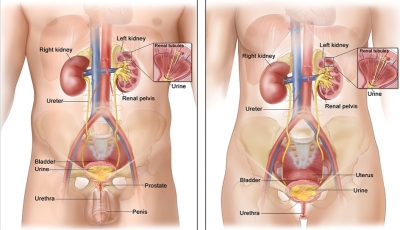
The kidneys release a non-stop trickle of urine, which is pushed towards the bladder by waves of muscle contractions. When the bladder fills up, it stretches and triggers sensors that send a signal to the brain. The person then feels the need to release urine. During urination, the muscles that seal the bladder relax. The bladder wall contracts to push the urine through the urethra and out of the body.
Urine is made in the kidneys and travels down two tubes called ureters to the bladder. The bladder stores urine, allowing urination to be infrequent and controlled. The bladder is lined by layers of muscle tissue that stretch to hold urine. The normal capacity of the bladder is 400-600 mL.
During urination, the bladder muscles squeeze, and two sphincters (valves) open to allow urine to flow out. Urine exits the bladder into the urethra, which carries urine out of the body. Because it passes through the penis, the urethra is longer in men (8 inches) than in women (1.5 inches).
Picture Credit : Google




